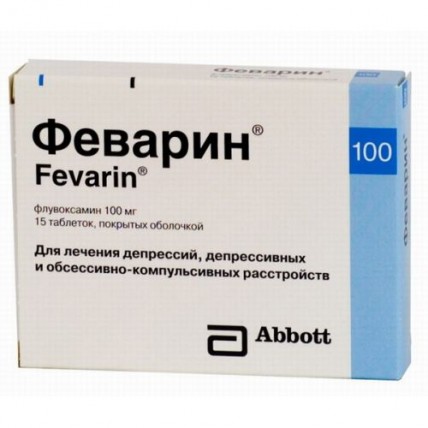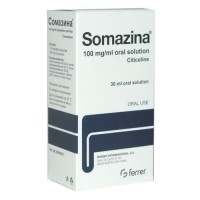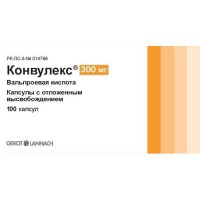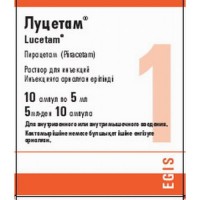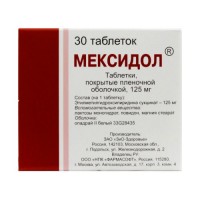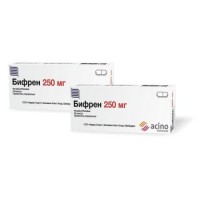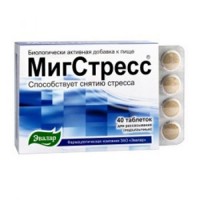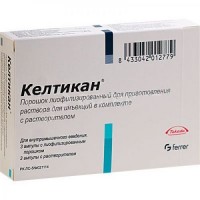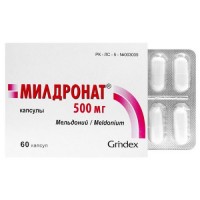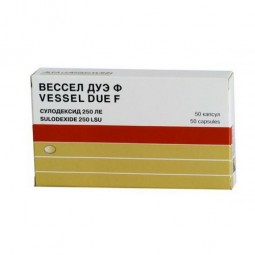Luvox 100 mg (15 film-coated tablets)
- $38.30
Феварин® (Fevarin®)
International unlicensed name (INN): fluvoksamina maleate (fluvoxamine maleate)
Dosage form: tablets for intake, film coated, with risky on the one hand
Structure
Active agents: fluvoksamina maleate of 50 or 100 mg.
Excipients:
Mannitolum,
corn starch,
previously gelated starch,
sodium of a stearil fumarate,
colloidal anhydrous dioxide of silicon,
methylhydroxypropyl cellulose,
polyethyleneglycol 6000,
talc,
the titan dioxide (E171).
Drug contains neither lactose, nor sugar (E121).
A pharmacodynamics
the Mechanism of action Fevarina® is connected with selective inhibition of the return serotonin reuptake by neurons of a brain and is characterized by the minimum influence on noradrenergichesky transfer. Феварин® has not significant ability to contact a-adrenergic, b-adrenergic, gistaminergichesky, muskarinovy cholinergic, dofaminergichesky or serotonergic receptors.
The pharmacokinetics
After intake of Fevarin® is completely soaked up from digestive tract. The maximum concentration of drug in blood plasma are noted in 3–8 h after introduction. The average plasma elimination half-life of blood making for a single dose of 13-15 h increases a little at multiple dose (17–22 h), and equilibrium concentration in blood plasma (steady-state), as a rule, are reached in 10–14 days.
Феварин® it biotransformirutsya in a liver (mainly by oxidizing demethylation) at least up to 9 metabolites which are removed through kidneys. 2 main metabolites possess is insignificant small pharmacological activity, other pharmacological are inactive. Extent of linking of Fevarina® with proteins of blood plasma of the person makes about 80% (in vitro).
Indications
Treatment and prevention of depressive disorders. Treatment of symptoms of obsessivny compulsive disorders.
It is contraindicated to apply contraindications of Fevarin® in combination with monoamine oxidase inhibitors (MAO inhibitors). The period between cancellation of MAO inhibitor of irreversible action and an initiation of treatment of Fevarinom® has to make not less than two weeks. Treatment of Fevarinom® can be begun already next day after cancellation of MAO inhibitor of reversible action (for example, a moklobemida). In principle the period between cancellation by Fevarina® and an initiation of treatment any MAO inhibitor has to make not less than 1 week
Besides, Fevarin® is contraindicated to patients with the known hypersensitivity to a fluvoksamin to a maleate or to one of the fillers which are a part of this drug and also patients with the profound abnormal liver functions.
Children should not appoint drug up to 8 years.
Use during pregnancy and in the period of
the Research lactation, the reproductions devoted to study at the laboratory animals receiving high doses of Fevarina® did not reveal decrease in fertility, disturbances of sexual behavior and teratogenic effects at their posterity. Nevertheless it is necessary to observe the usual precautionary measures concerning use of any medicines during pregnancy. Феварин® in small amounts gets into breast milk. In this regard it cannot be applied in the period of a lactation.
Precautionary measures
At the patients having a depression the probability of attempts of a suicide which can remain before achievement of sufficient remission, as a rule, is high.
Treatment of the patients having a liver or renal failure should be begun with low doses of Fevarina® under stringent medical control. In rare instances treatment of Fevarinom® can lead to the increase in activity of enzymes of a liver most of which often is followed by the corresponding clinical symptoms. In these cases the reception of Fevarina® has to be cancelled. In spite of the fact that in researches on laboratory animals fluvoksamin did not cause convulsive activity, it is necessary to show care when prescribing drug the patient with spasms in the anamnesis. Treatment of Fevarinom® should be stopped in case of development of an epileptic seizure. The data obtained at treatment of elderly and young patients confirm lack of clinically significant differences between the daily doses which were usually applied at them. Nevertheless increase in doses of drug at elderly patients always should be carried out more slowly and with bigger care.
Феварин® can lead to insignificant decrease in heart rate (on 2–6 ud. / mines).
Due to the lack of clinical experience of Fevarin® it is not recommended to apply to treatment of depressions at children.
There are messages about such abnormal intracutaneous hemorrhages as an ecchymoma and a purpura observed at use of selective inhibitors of the return serotonin reuptake. It is necessary to show care when prescribing these medicines, especially, if it is about the patients who are at the same time taking the drugs which influence function of thrombocytes (for example, atypical antipsychotic means and fenotiazina, many tricyclic antidepressants, aspirin, non-steroidal anti-inflammatory drugs) and also about patients with bleedings in the anamnesis.
Interaction with other
Fevarin® medicines cannot be applied in combination with MAO inhibitors. Феварин® can prolong elimination of the drugs metaboliziruyemy by oxidation in a liver. Perhaps clinically significant interaction with the drugs which are characterized by narrow dependence 'dose effect' (for example, warfarin, Phenytoinum, theophylline, clozapine and carbamazepine).
Against the background of use of Fevarina® the slight increase of concentration in blood plasma of benzodiazepines metaboliziruyemy in a liver by oxidation can be observed.
At simultaneous use of Fevarina® the increase in earlier stable levels of tricyclic antidepressants was observed. In this regard it is not recommended to appoint Fevarin® in combination with these drugs.
In the researches devoted to studying interactions of Fevarina® the increase in concentration of propranolol after introduction of Fevarina® was noted. In this regard it is possible to recommend a propranolol dose decline in case of additional purpose of Fevarina®.
At use of Fevarina® in a combination with warfarin during 2 weeks the significant increase in concentration of warfarin in blood plasma and lengthening of a prothrombin time was observed. Thus, at the patients accepting inside anticoagulants and Fevarin® it is necessary to control a prothrombin time and as appropriate to select anticoagulant doses.
Феварин® does not interact with digoxin and atenolol.
Феварин® it was applied in combination with lithium drugs to treatment of the heavy patients who are badly answering pharmacotherapy. It should be noted that lithium (and, perhaps, tryptophane) enhances serotonergic effects of Fevarina® therefore such combined pharmacotherapy has to be carried out with care.
As well as at use of other psychotropic drugs, during treatment of Fevarinom® it is not recommended to consume alcohol.
Influence on ability to driving of the car or to control of machines and
Fevarin® mechanisms, appointed to healthy volunteers in doses up to 150 mg, did not influence the psychomotor functions connected with driving of the car or control of cars and mechanisms. At the same time there are messages about the drowsiness noted during treatment of Fevarinom®. In this regard it is recommended to show care before final definition of individual reaction to drug.
A route of administration and doses
of the Depression
the Recommended starting dose makes 50 or 100 mg (once, in the evening). Gradual increase in a starting dose to the level of an effective dose is recommended. The effective daily dose which is usually making 100 mg is selected individually depending on reaction of the patient to treatment. The daily dose can reach 300 mg. Daily doses over 150 mg should be distributed on several receptions.
According to official WHO recommendations the treatment by antidepressants should be continued at least within 6 months. after treatment of a depressive episode.
For prevention of a recurrence of a depression about 100 mg of Fevarina® are recommended to accept once a day.
Obsessivny compulsive disorders
It is recommended to begin with a dose 50 mg of Fevarina® a day within 3–4 days. The effective daily dose makes, as a rule, from 100 to 300 mg. Doses should be raised gradually to achievement of an effective daily dose which should not exceed 300 mg at adults. Doses up to 150 mg can be accepted once, it is desirable in the evening. Daily doses over 150 mg are recommended to be distributed on 2 or 3 receptions.
Doses for children are more senior than 8 years and teenagers
the Initial dose makes 25 mg/days on one reception. A maintenance dose - 50–200 mg/days. The daily dose should not exceed 200 mg. Daily doses over 100 mg are recommended to be distributed on 2 or 3 receptions.
At the good answer to drug the treatment can be continued by means of individually picked up daily dose. If improvement is not reached in 10 weeks of treatment, reception of a fluvoksamin should be cancelled. Still system researches which could show how treatment fluvoksaminy can long be carried out were not organized, however obsessivny compulsive disorders have chronic character therefore it is possible to consider expedient extension of treatment of Fevarinom® over 10 weeks at the patients who well answered this drug. Selection of the minimum effective maintenance dose has to be carried out with care individually. Some clinical physicians recommend carrying out the accompanying psychotherapy at the patients who well answered pharmacotherapy.
Treatment of the patients having a liver or renal failure should be begun with the smallest doses under stringent medical control.
The pill Fevarin® should be taken without chewing and washing down with a small amount of water.
Side effects
the Most often observed symptom connected with use of Fevarina® - the nausea which sometimes is followed by vomiting. This by-effect, as a rule, disappears in the first 2 weeks of treatment.
Other side effects observed when conducting controlled clinical trials more than at 1% of patients and noted more often than at placebo use:
from the central nervous system: drowsiness, dizziness, a headache, insomnia, alarm, psychomotor excitement, sensation of fear, a tremor,
from a digestive tract: a constipation, anorexia, dyspepsia, diarrhea, unpleasant feelings in epigastric area, dryness in a mouth, sensation of discomfort,
from integuments: the strengthened sweating,
other: asthenia, heartbeat, tachycardia.
As well as at use of other selective inhibitors of the return serotonin reuptake, the tranzitorny hyponatremia stopping after cancellation of Fevarina® was seldom observed. In certain cases it could be caused by a syndrome of inadequate secretion of antidiuretic hormone. The majority of messages was connected with treatment of patients of senile age.
Hemorrhages: see. 'Precautionary measures'.
Increase or degrowth of a body can sometimes be observed.
In rare instances after sharp cancellation of Fevarina® such symptoms as a headache, nausea, dizziness and sensation of fear were noted.
Some of the undesirable phenomena mentioned above can be symptoms of a depression and optional Fevarinom® are caused.
Overdose
Symptoms
belong To the most characteristic symptoms gastrointestinal disorders (nausea, vomiting and diarrhea), drowsiness and dizziness. Besides, there are messages about disturbances of warm activity (tachycardia, bradycardia, arterial hypotension), abnormal liver functions, spasms and even a coma.
So far over 300 messages about cases of deliberate overdose of Fevarina® arrived. The highest registered dose of Fevarina® received by one patient made 10,000 mg, this patient was cured as a result of purely symptomatic therapy. More serious complications were observed in cases of deliberate overdose of Fevarina® against the background of the accompanying pharmacotherapy.
Treatment
of Specific antidote does not exist. At overdose the gastric lavage which has to be carried out as soon as possible after administration of drug and also symptomatic treatment is recommended. Besides, multiple dose of activated carbon is recommended. The profound diuresis or dialysis are represented unjustified.
A form of release
of the Tablet, film coated, with risky on the one hand, in the blisters laid in cardboard packings on 15 tablets (50 mg of a fluvoksamin of a maleate or on 15 tablets of 100 mg of a fluvoksamin of a maleate).
Storage conditions
In the dry place protected from direct sunlight at a temperature not above 25 °C.
Out of children's reach.
An expiration date
3 years on condition of storage in the intact original packing.
Drug cannot be used after an expiration date.
Prescription status
It is released on the prescription of the doctor.
To develop
International unlicensed name (INN): fluvoksamina maleate (fluvoxamine maleate)
Dosage form: tablets for intake, film coated, with risky on the one hand
Structure
Active agents: fluvoksamina maleate of 50 or 100 mg.
Excipients:
Mannitolum,
corn starch,
previously gelated starch,
sodium of a stearil fumarate,
colloidal anhydrous dioxide of silicon,
methylhydroxypropyl cellulose,
polyethyleneglycol 6000,
talc,
the titan dioxide (E171).
Drug contains neither lactose, nor sugar (E121).
A pharmacodynamics
the Mechanism of action Fevarina® is connected with selective inhibition of the return serotonin reuptake by neurons of a brain and is characterized by the minimum influence on noradrenergichesky transfer. Феварин® has not significant ability to contact a-adrenergic, b-adrenergic, gistaminergichesky, muskarinovy cholinergic, dofaminergichesky or serotonergic receptors.
The pharmacokinetics
After intake of Fevarin® is completely soaked up from digestive tract. The maximum concentration of drug in blood plasma are noted in 3–8 h after introduction. The average plasma elimination half-life of blood making for a single dose of 13-15 h increases a little at multiple dose (17–22 h), and equilibrium concentration in blood plasma (steady-state), as a rule, are reached in 10–14 days.
Феварин® it biotransformirutsya in a liver (mainly by oxidizing demethylation) at least up to 9 metabolites which are removed through kidneys. 2 main metabolites possess is insignificant small pharmacological activity, other pharmacological are inactive. Extent of linking of Fevarina® with proteins of blood plasma of the person makes about 80% (in vitro).
Indications
Treatment and prevention of depressive disorders. Treatment of symptoms of obsessivny compulsive disorders.
It is contraindicated to apply contraindications of Fevarin® in combination with monoamine oxidase inhibitors (MAO inhibitors). The period between cancellation of MAO inhibitor of irreversible action and an initiation of treatment of Fevarinom® has to make not less than two weeks. Treatment of Fevarinom® can be begun already next day after cancellation of MAO inhibitor of reversible action (for example, a moklobemida). In principle the period between cancellation by Fevarina® and an initiation of treatment any MAO inhibitor has to make not less than 1 week
Besides, Fevarin® is contraindicated to patients with the known hypersensitivity to a fluvoksamin to a maleate or to one of the fillers which are a part of this drug and also patients with the profound abnormal liver functions.
Children should not appoint drug up to 8 years.
Use during pregnancy and in the period of
the Research lactation, the reproductions devoted to study at the laboratory animals receiving high doses of Fevarina® did not reveal decrease in fertility, disturbances of sexual behavior and teratogenic effects at their posterity. Nevertheless it is necessary to observe the usual precautionary measures concerning use of any medicines during pregnancy. Феварин® in small amounts gets into breast milk. In this regard it cannot be applied in the period of a lactation.
Precautionary measures
At the patients having a depression the probability of attempts of a suicide which can remain before achievement of sufficient remission, as a rule, is high.
Treatment of the patients having a liver or renal failure should be begun with low doses of Fevarina® under stringent medical control. In rare instances treatment of Fevarinom® can lead to the increase in activity of enzymes of a liver most of which often is followed by the corresponding clinical symptoms. In these cases the reception of Fevarina® has to be cancelled. In spite of the fact that in researches on laboratory animals fluvoksamin did not cause convulsive activity, it is necessary to show care when prescribing drug the patient with spasms in the anamnesis. Treatment of Fevarinom® should be stopped in case of development of an epileptic seizure. The data obtained at treatment of elderly and young patients confirm lack of clinically significant differences between the daily doses which were usually applied at them. Nevertheless increase in doses of drug at elderly patients always should be carried out more slowly and with bigger care.
Феварин® can lead to insignificant decrease in heart rate (on 2–6 ud. / mines).
Due to the lack of clinical experience of Fevarin® it is not recommended to apply to treatment of depressions at children.
There are messages about such abnormal intracutaneous hemorrhages as an ecchymoma and a purpura observed at use of selective inhibitors of the return serotonin reuptake. It is necessary to show care when prescribing these medicines, especially, if it is about the patients who are at the same time taking the drugs which influence function of thrombocytes (for example, atypical antipsychotic means and fenotiazina, many tricyclic antidepressants, aspirin, non-steroidal anti-inflammatory drugs) and also about patients with bleedings in the anamnesis.
Interaction with other
Fevarin® medicines cannot be applied in combination with MAO inhibitors. Феварин® can prolong elimination of the drugs metaboliziruyemy by oxidation in a liver. Perhaps clinically significant interaction with the drugs which are characterized by narrow dependence 'dose effect' (for example, warfarin, Phenytoinum, theophylline, clozapine and carbamazepine).
Against the background of use of Fevarina® the slight increase of concentration in blood plasma of benzodiazepines metaboliziruyemy in a liver by oxidation can be observed.
At simultaneous use of Fevarina® the increase in earlier stable levels of tricyclic antidepressants was observed. In this regard it is not recommended to appoint Fevarin® in combination with these drugs.
In the researches devoted to studying interactions of Fevarina® the increase in concentration of propranolol after introduction of Fevarina® was noted. In this regard it is possible to recommend a propranolol dose decline in case of additional purpose of Fevarina®.
At use of Fevarina® in a combination with warfarin during 2 weeks the significant increase in concentration of warfarin in blood plasma and lengthening of a prothrombin time was observed. Thus, at the patients accepting inside anticoagulants and Fevarin® it is necessary to control a prothrombin time and as appropriate to select anticoagulant doses.
Феварин® does not interact with digoxin and atenolol.
Феварин® it was applied in combination with lithium drugs to treatment of the heavy patients who are badly answering pharmacotherapy. It should be noted that lithium (and, perhaps, tryptophane) enhances serotonergic effects of Fevarina® therefore such combined pharmacotherapy has to be carried out with care.
As well as at use of other psychotropic drugs, during treatment of Fevarinom® it is not recommended to consume alcohol.
Influence on ability to driving of the car or to control of machines and
Fevarin® mechanisms, appointed to healthy volunteers in doses up to 150 mg, did not influence the psychomotor functions connected with driving of the car or control of cars and mechanisms. At the same time there are messages about the drowsiness noted during treatment of Fevarinom®. In this regard it is recommended to show care before final definition of individual reaction to drug.
A route of administration and doses
of the Depression
the Recommended starting dose makes 50 or 100 mg (once, in the evening). Gradual increase in a starting dose to the level of an effective dose is recommended. The effective daily dose which is usually making 100 mg is selected individually depending on reaction of the patient to treatment. The daily dose can reach 300 mg. Daily doses over 150 mg should be distributed on several receptions.
According to official WHO recommendations the treatment by antidepressants should be continued at least within 6 months. after treatment of a depressive episode.
For prevention of a recurrence of a depression about 100 mg of Fevarina® are recommended to accept once a day.
Obsessivny compulsive disorders
It is recommended to begin with a dose 50 mg of Fevarina® a day within 3–4 days. The effective daily dose makes, as a rule, from 100 to 300 mg. Doses should be raised gradually to achievement of an effective daily dose which should not exceed 300 mg at adults. Doses up to 150 mg can be accepted once, it is desirable in the evening. Daily doses over 150 mg are recommended to be distributed on 2 or 3 receptions.
Doses for children are more senior than 8 years and teenagers
the Initial dose makes 25 mg/days on one reception. A maintenance dose - 50–200 mg/days. The daily dose should not exceed 200 mg. Daily doses over 100 mg are recommended to be distributed on 2 or 3 receptions.
At the good answer to drug the treatment can be continued by means of individually picked up daily dose. If improvement is not reached in 10 weeks of treatment, reception of a fluvoksamin should be cancelled. Still system researches which could show how treatment fluvoksaminy can long be carried out were not organized, however obsessivny compulsive disorders have chronic character therefore it is possible to consider expedient extension of treatment of Fevarinom® over 10 weeks at the patients who well answered this drug. Selection of the minimum effective maintenance dose has to be carried out with care individually. Some clinical physicians recommend carrying out the accompanying psychotherapy at the patients who well answered pharmacotherapy.
Treatment of the patients having a liver or renal failure should be begun with the smallest doses under stringent medical control.
The pill Fevarin® should be taken without chewing and washing down with a small amount of water.
Side effects
the Most often observed symptom connected with use of Fevarina® - the nausea which sometimes is followed by vomiting. This by-effect, as a rule, disappears in the first 2 weeks of treatment.
Other side effects observed when conducting controlled clinical trials more than at 1% of patients and noted more often than at placebo use:
from the central nervous system: drowsiness, dizziness, a headache, insomnia, alarm, psychomotor excitement, sensation of fear, a tremor,
from a digestive tract: a constipation, anorexia, dyspepsia, diarrhea, unpleasant feelings in epigastric area, dryness in a mouth, sensation of discomfort,
from integuments: the strengthened sweating,
other: asthenia, heartbeat, tachycardia.
As well as at use of other selective inhibitors of the return serotonin reuptake, the tranzitorny hyponatremia stopping after cancellation of Fevarina® was seldom observed. In certain cases it could be caused by a syndrome of inadequate secretion of antidiuretic hormone. The majority of messages was connected with treatment of patients of senile age.
Hemorrhages: see. 'Precautionary measures'.
Increase or degrowth of a body can sometimes be observed.
In rare instances after sharp cancellation of Fevarina® such symptoms as a headache, nausea, dizziness and sensation of fear were noted.
Some of the undesirable phenomena mentioned above can be symptoms of a depression and optional Fevarinom® are caused.
Overdose
Symptoms
belong To the most characteristic symptoms gastrointestinal disorders (nausea, vomiting and diarrhea), drowsiness and dizziness. Besides, there are messages about disturbances of warm activity (tachycardia, bradycardia, arterial hypotension), abnormal liver functions, spasms and even a coma.
So far over 300 messages about cases of deliberate overdose of Fevarina® arrived. The highest registered dose of Fevarina® received by one patient made 10,000 mg, this patient was cured as a result of purely symptomatic therapy. More serious complications were observed in cases of deliberate overdose of Fevarina® against the background of the accompanying pharmacotherapy.
Treatment
of Specific antidote does not exist. At overdose the gastric lavage which has to be carried out as soon as possible after administration of drug and also symptomatic treatment is recommended. Besides, multiple dose of activated carbon is recommended. The profound diuresis or dialysis are represented unjustified.
A form of release
of the Tablet, film coated, with risky on the one hand, in the blisters laid in cardboard packings on 15 tablets (50 mg of a fluvoksamin of a maleate or on 15 tablets of 100 mg of a fluvoksamin of a maleate).
Storage conditions
In the dry place protected from direct sunlight at a temperature not above 25 °C.
Out of children's reach.
An expiration date
3 years on condition of storage in the intact original packing.
Drug cannot be used after an expiration date.
Prescription status
It is released on the prescription of the doctor.
To develop
